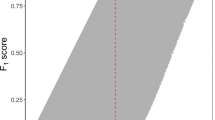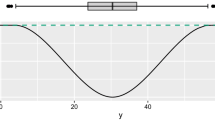Abstract
The one-versus-one (OVO) binarization decomposition scheme is considered as one of the most effective techniques to deal with multi-class classification problems. Its inherent mechanism is to use the “divide-and-conquer” strategy to decompose the multi-class classification problem into as many pairs of easier-to-solve binary sub-problems as possible. One common issue in the OVO scheme is that of non-competent classifiers. In this study, we proposed a novel OVO scheme strategy, named DRCW-FRkNN-OVO, to reduce the negative effect of non-competent classifiers. Specifically, we focused on the definition of region of competence, which plays a crucial role in managing the non-competent classifiers. To overcome the issue of skew and sparse distribution during the management of non-competent classifiers, we developed a relative competence weighting combination method via the fixed radius nearest neighbour search to find the local region within each class for the query sample. Our proposed DRCW-FRkNN-OVO is tested on 30 real-world multi-class datasets compared with several well-known related works. Experimental results supported by thorough statistical analysis confirmed the effectiveness and robustness of our proposed method.

Similar content being viewed by others
References
Aha DW, Kibler D, Albert MK (1991) Instance-based learning algorithms. Mach Learn 6(1):37–66
AL-Sharuee MT, Liu F, Pratama M (2018) Sentiment analysis: an automatic contextual analysis and ensemble clustering approach and comparison. Data Knowl Eng 115:194–213
Alcalá-Fdez J, Sanchez L, Garcia S, del Jesus MJ, Ventura S, Garrell JM, Otero J, Romero C, Bacardit J, Rivas VM et al (2009) KEEL: a software tool to assess evolutionary algorithms for data mining problems. Soft Comput 13(3):307–318
Allwein EL, Schapire RE, Singer Y (2000) Reducing multiclass to binary: a unifying approach for margin classifiers. J Mach Learn Res 1:113–141
Alqudah AM (2020) AOCT-NET: a convolutional network automated classification of multiclass retinal diseases using spectral-domain optical coherence tomography images. Med Biol Eng Comput 58(1):41–53
Bouazizi M, Ohtsuki T (2019) Multi-class sentiment analysis on twitter: classification performance and challenges. Big Data Min Anal 2(3):181–194
Breiman L, Friedman J, Stone CJ, Olshen RA (1984) Classification and regression trees. CRC Press, Boca Raton
Cerf L, Gay D, Selmaoui-Folcher N, Crémilleux B, Boulicaut JF (2013) Parameter-free classification in multi-class imbalanced data sets. Data Knowl Eng 87:109–129
Chang CC, Lin CJ (2011) LIBSVM: a library for support vector machines. ACM Trans Intell Syst Technol (TIST) 2(3):1–27
Clark P, Boswell R (1991) Rule induction with CN2: some recent improvements. European working session on learning. Springer, Berlin, pp 151–163
Cohen J (1960) A coefficient of agreement for nominal scales. Educ Psychol Meas 20(1):37–46
Demšar J (2006) Statistical comparisons of classifiers over multiple data sets. J Mach Learn Res 7:1–30
Derrac J, García S, Molina D, Herrera F (2011) A practical tutorial on the use of nonparametric statistical tests as a methodology for comparing evolutionary and swarm intelligence algorithms. Swarm Evol Comput 1(1):3–18
Dietterich TG, Bakiri G (1994) Solving multiclass learning problems via error-correcting output codes. J Artif Intell Res 2:263–286
Don DR, Iacob IE (2020) DCSVM: fast multi-class classifcation using support vector machines. Int J Mach Learn Cybern 11:433–447
Fernandes ER, de Carvalho AC (2019) Evolutionary inversion of class distribution in overlapping areas for multi-class imbalanced learning. Inf Sci 494:141–154
Fernández A, Calderón M, Barrenechea E, Bustince H, Herrera F (2010) Solving multi-class problems with linguistic fuzzy rule based classification systems based on pairwise learning and preference relations. Fuzzy Sets Syst 161(23):3064–3080
Friedman J (1996) Another approach to polychotomous classification. Department of Statistics, Stanford University, Tech. rep
Galar M, Fernández A, Barrenechea E, Bustince H, Herrera F (2011) An overview of ensemble methods for binary classifiers in multi-class problems: experimental study on one-vs-one and one-vs-all schemes. Pattern Recogn 44(8):1761–1776
Galar M, Fernández A, Barrenechea E, Bustince H, Herrera F (2013) Dynamic classifier selection for one-vs-one strategy: avoiding non-competent classifiers. Pattern Recogn 46(12):3412–3424
Galar M, Fernández A, Barrenechea E, Herrera F (2015) DRCW-OVO: distance-based relative competence weighting combination for one-vs-one strategy in multi-class problems. Pattern Recogn 48(1):28–42
García S, Fernández A, Luengo J, Herrera F (2010) Advanced nonparametric tests for multiple comparisons in the design of experiments in computational intelligence and data mining: experimental analysis of power. Inf Sci 180(10):2044–2064
García S, Zhang ZL, Altalhi A, Alshomrani S, Herrera F (2018) Dynamic ensemble selection for multi-class imbalanced datasets. Inf Sci 445:22–37
Hall M, Frank E, Holmes G, Pfahringer B, Reutemann P, Witten IH (2009) The WEKA data mining software: an update. ACM SIGKDD Explor Newsl 11(1):10–18
Hühn JC, Hüllermeier E (2008) FR3: a fuzzy rule learner for inducing reliable classifiers. IEEE Trans Fuzzy Syst 17(1):138–149
Hüllermeier E, Brinker K (2008) Learning valued preference structures for solving classification problems. Fuzzy Sets Syst. 159(18):2337–2352
Hüllermeier E, Vanderlooy S (2010) Combining predictions in pairwise classification: an optimal adaptive voting strategy and its relation to weighted voting. Pattern Recogn 43(1):128–142
Islam MM, Kim JM (2019) Reliable multiple combined fault diagnosis of bearings using heterogeneous feature models and multiclass support vector machines. Reliab Eng Syst Saf 184:55–66
Karagoz GN, Yazici A, Dokeroglu T, Cosar A (2021) A new framework of multi-objective evolutionary algorithms for feature selection and multi-label classification of video data. Int J Mach Learn Cybern 12(1):53–71
Knerr S, Personnaz L, Dreyfus G (1990) Single-layer learning revisited: a stepwise procedure for building and training a neural network. Neurocomputing: Algorithms. Archit Appl 68:41–50
Liu Y, Bi JW, Fan ZP (2017) Multi-class sentiment classification: the experimental comparisons of feature selection and machine learning algorithms. Expert Syst Appl 80:323–339
Nayak DR, Dash R, Majhi B (2020) Automated diagnosis of multi-class brain abnormalities using mri images: a deep convolutional neural network based method. Pattern Recogn Lett 138:385–391
Orlovsky S (1978) Decision-making with a fuzzy preference relation. Fuzzy Sets Syst 1(3):155–167
Pang Y, He Q, Jiang G, Xie P (2020) Spatio-temporal fusion neural network for multi-class fault diagnosis of wind turbines based on scada data. Renew Energy 161:510–524
Platt JC (1999) Probabilistic outputs for support vector machines and comparisons to regularized likelihood methods. Adv Large Margin Classif 10(3):61–74
Ramzan F, Khan MUG, Rehmat A, Iqbal S, Saba T, Rehman A, Mehmood Z (2020) A deep learning approach for automated diagnosis and multi-class classification of Alzheimer’s disease stages using resting-state fmri and residual neural networks. J Med Syst 44(2):37
Vapnik V (1998) Statistical learning theory. Wiley, New York
Villacampa-Calvo C, Zaldivar B, Garrido-Merchán EC, Hernández-Lobato D (2020) Multi-class gaussian process classification with noisy inputs
Wilcoxon F (1945) Individual comparisons by ranking methods. Biom Bull 1(6):80–83
Wilson DR, Martinez TR (1997) Improved heterogeneous distance functions. J Artif Intell Res 6(1):1–34
Wu S, Xia X, Liu T, Han B, Gong M, Wang N, Liu H, Niu G (2020) Multi-class classification from noisy-similarity-labeled data. arXiv preprint arXiv:200206508
Xu F, Pan Z, Xia R (2020) E-commerce product review sentiment classification based on a na\(\ddot{i}\)ve bayes continuous learning framework. Inf Process Manag 57(5):102221
Zhang X, Ding S, Sun T (2016) Multi-class LSTMSVM based on optimal directed acyclic graph and shuffled frog leaping algorithm. Int J Mach Learn Cybern 7:241–251
Acknowledgements
The authors would like to thank the (anonymous) reviewers for their constructive comments. This research was supported by Zhejiang Provincial Natural Science Foundation of China under Grant No. LZ20G010001, the National Science Foundation of China under Grant Nos. 71801065, 71831006, 71771070, and 71932005, as well as the Hangzhou 2019 Philosophy and Social Science Planning Project of China under Grant No. Z19JC112.
Author information
Authors and Affiliations
Corresponding author
Additional information
Publisher's Note
Springer Nature remains neutral with regard to jurisdictional claims in published maps and institutional affiliations.
Rights and permissions
About this article
Cite this article
Zhang, ZL., Luo, XG. & Zhou, Q. DRCW-FRkNN-OVO: distance-based related competence weighting based on fixed radius k nearest neighbour for one-vs-one scheme. Int. J. Mach. Learn. & Cyber. 13, 1441–1459 (2022). https://doi.org/10.1007/s13042-021-01458-7
Received:
Accepted:
Published:
Issue Date:
DOI: https://doi.org/10.1007/s13042-021-01458-7




